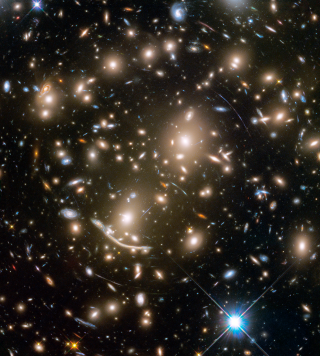Bibcode
Aguerri, J. A. L.; Méndez-Abreu, J.; Corsini, E. M.
Referencia bibliográfica
Astronomy and Astrophysics, Volume 495, Issue 2, 2009, pp.491-504
Fecha de publicación:
2
2009
Revista
Número de citas
311
Número de citas referidas
278
Descripción
Context: Bars are very common in the centre of the disc galaxies, and
they drive the evolution of their structure. The state-of-the-art
imaging and redshift surveys of galaxies allow us to study the
relationships between the properties of the bars and those of their
hosts in statistically significant samples. Aims: A
volume-limited sample of 2106 disc galaxies was studied to derive the
bar fraction, length, and strength as a function of the morphology,
size, local galaxy density, light concentration, and colour of the host
galaxy. The sample galaxies were selected to not be strongly
disturbed/interacting. Methods: The bar and galaxy properties were
obtained by analysing the r-band images of the sample galaxies available
in the Sloan Digital Sky Survey Data Release 5. Results: The bars
were detected using the ellipse fitting method and Fourier analysis
method. They were tested and calibrated with extensive simulations on
artificial images. The ellipse fitting method was found to be more
efficient in detecting bars in spiral galaxies. The fraction of barred
galaxies turned out to be 45%. A bar was found in 29% of the lenticular
galaxies, in 55% and 54% of the early- and late-type spirals,
respectively. The bar length (normalised by the galaxy size) of
late-type spirals is shorter than in early-type or lenticular ones. A
correlation between the bar length and galaxy size was found with longer
bars hosted by larger galaxies. The bars of the lenticular galaxies are
weaker than those in spirals. Moreover, the unimodal distribution of the
bar strength found for all the galaxy types argues against a quick
transition between the barred and unbarred statues. There is no
difference between the local galaxy density of barred and unbarred
galaxies. Besides, neither the length nor strength of the bars are
correlated with the local density of the galaxy neighbourhoods. In
contrast, a statistical significant difference between the central light
concentration and colour of barred and unbarred galaxies was found. Bars
are mostly located in less concentrated and bluer galaxies. Conclusions: These results indicate that the properties of bars are
strongly related to those of their host galaxies, but do not depend on
the local environment.
Proyectos relacionados

Grupo de Estudios de Formación Estelar GEFE
El proyecto interno GEFE está enmarcado en el proyecto coordinado, ESTALLIDOS, financiado por el plan nacional desde el año 2001. El ultimo proyecto aprobado es ESTALLIDOS 6.0 (AYA2016- 79724-C4-2-P). En el proyecto GEFE trabajamos en base al caso científico del proyecto ESTALLIDOS 6.0. Los estallidos de formación estelar (Starbursts o SB) son
Casiana
Muñoz Tuñón

Evolución de Galaxias en Cúmulos
Las estructuras en el Universo, a todas las escalas de masa, se han formado de una forma jerárquica y principalmente producidas por fusiones de galaxias. Sin embargo, esta formación jerárquica de las galaxias está modulada por el entorno en el cual se crean y evolucionan. Mientras que las galaxias de campo presentan una evolución pasiva, los
Jairo
Méndez Abreu